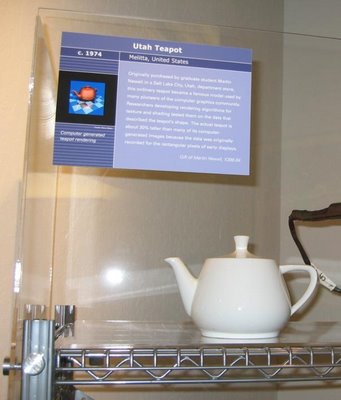This object is historically one of the first complex 3D models to be rendered in computer graphics. It consisted of about 110 vertices, and was generated by Martin Newell in 1974 using hand-drawn Bezier curves, based on a real teapot that he and his wife had bought. This model served as a basis for comparing various 3D rendering methodologies for lighting, textures, bump-mapping, etc. By the standards of 2002, the model is trivial to render and thus is often not suited to demonstrate the complexity of modern research. Despite this, the tea pot still appears, now and then, in recent papers.

The teapot was made by Melitta in 1974 and originally belonged to Martin Newell and his wife, Sandra - who purchased it from ZCMI, (a department store in Salt Lake City).
The teapot was eventually donated to the Boston Computer Museum but now resides in the Ephemera collection of the Computer History Museum.
It's catalogued as "Teapot used for Computer Graphics rendering" and bears the catalogue number X00398.1984
for more info http://www.sjbaker.org/teapot/
 The teapot was made by Melitta in 1974 and originally belonged to Martin Newell and his wife, Sandra - who purchased it from ZCMI, (a department store in Salt Lake City).
The teapot was made by Melitta in 1974 and originally belonged to Martin Newell and his wife, Sandra - who purchased it from ZCMI, (a department store in Salt Lake City). 
No comments:
Post a Comment